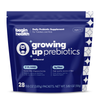How Mom’s Gut Microbiome Impacts Her Baby
share this article

How do babies acquire their microbiomes? Are babies born without them? And do babies’ gut microbiomes resemble that of their mother’s? Since the gut microbiome is crucial for baby’s health and well-being, it’s important to examine how a mother’s gut microbiome can affect her baby before, during and after birth.
What is the maternal microbiome?
First let’s understand that the microbiome is defined as the genetic material of all microorganisms- including bacteria, parasites, and viruses- colonized in an environment [1]. The human microbiome consists of trillions of microbial cells [2], and these microorganisms live in gut, stomach, oral cavity, vagina, mammary glands, skin, and respiratory tract [3]. When we consider the potential interactions between mom and baby before, during and after birth, the maternal microbiome in the gut, vagina, on the skin, and in mammary glands can be transferred to her baby.
In our body, most of our bacteria are located in the gut, and colonized in the colon [4]. A disrupted maternal gut microbiome is associated with prenatual issues like shorter gestational age, lower birth weight, and poor psychological development for an infant. Aside from prenatal effects of maternal gut microbiome, the maternal microbiome can be shared with infants during the birth based on how baby is delivered along with maternal vaginal and skin microbiome [5]. After birth, the human milk microbiome and skin microbiome are passed to infants via breastfeeding. Thus, the maternal microbiome colonized in the gut, on the skin, in the reproductive tract, and the mammary glands can influence the pregnancy outcomes, the fetus’ development, and establishing the infant’s microbiome.
The factors we know influence the maternal microbiome, and indirectly infants' health.
The maternal microbiome may influence the development of the baby's microbiome via the transfer of bacteria through childbirth. The seeding of an infant’s microbiome may even start before the birth. Originally it was believed that the womb is sterile, and a fetus was not exposed to any microbes during pregnancy until time of delivery. However, recently researchers have found particles that are produced by bacteria in the placenta [6]. To support these findings, a recent study showed that more than half of the microbial families identified in meconium, baby’s first poop, were also detected in the placenta and amniotic fluid. Specifically, bacteria from the same genera like Escherichia/Shigella, Lactobacillus and Propionibacterium were found in meconium, placenta and amniotic fluid [7]. Although still we do not know enough about the microbiome transmission of the gut microbiome during pregnancy [3], these findings can imply that a baby’s gut microbiome begins shaping before birth. Thus, the maternal gut microbiome before and during pregnancy is a critical factor in baby’s development.
Lifestyle and environmental factors of the mother, like diet, physical activity, tobacco exposure, antibiotic usage, and pet exposure, all play a role in the characteristics of the maternal microbiome. For example, infants of a mom who consumed high fruits and vegetable during pregnancy had a higher abundance of Cutibacterium, Parabacteroides, and Lactococcus in their stool when compared to moms with low fruits and vegetable intake. These types of bacteria have several benefits like immune system regulation, improving intestine health, and increased protection from infection [8]. This implies that maternal lifestyle can have both short and long-term impacts on her infant’s health.
How prenatal antibiotic exposure impacts baby’s health
Research shows that prenatal antibiotic usage disturbs the microbiome for both mom and baby. A recent study found a significant difference in abundance of bacteria when they compared the gut microbiome of infants prenatally exposed to antibiotics with infants without antibiotic exposure during pregnancy. For example, the abundance of Lachnospiraceae family was greater in prenatally antibiotics exposed infants compared to infants not exposed at 12 months. We know that the higher Lachnospiraceae abundance is related with higher body weight in children [9]. The alteration in microbiome due to antibiotic usage during pregnancy can have long-term effects on babies’ health including childhood obesity [10, 11], asthma [12], atopic dermatitis, and food allergies [13].
How delivery type can influence the development of a baby’s microbiome.
Delivery is a crucial experience for the microbiome transmission. Researchers have found a significant difference in the microbiome of naturally delivered babies and those delivered via cesarean.
The gut microbiome of babies delivered vaginally is similar to the gut microbiome of their mother. In comparison, babies born by cesarean section have bacteria that more closely resembles the hospital environment where they were born and their mom’s skin [14].
Specifically, abundance of Bacteroides species in the gut microbiome is lower in infants delivered via cesarean section when compared to naturally delivered babies. Note that a Bacteroides dominant microbiome is associated with better cognitive functions in infants [15]. A recent study from Boston showed that Bacteroides species were detected in the gut microbiome of infants born by both cesarean section and vaginal delivery in the first days of infant life. However, babies delivered via cesarean section lost the Bacteroides species at week two, while it was still abundant in vaginally delivered infants.
Daily reads to help your little ones lead happier and healthier lives.
Join the
Happy Gut Club
Transfer of maternal microbiome to babies after birth: Does breastfeeding influence babies’ microbiome?
Over 800 bacterial species live in the human milk microbiome, and these microorganisms seed a baby’s gut and oral microbiome via breastfeeding.
A breastfed baby consumes from 1×105 to 1×107 bacteria through breastfeeding each day, which represent one third of the baby’s gut bacteria. The microbiota acquired via breastfeeding is sourced from the maternal gut, maternal skin, environment, and infant’s mouth. We know that mom’s diet before or after birth, physical activity, tobacco exposure, body weight, geographical location, socioeconomic status, lactation stage, delivery type, parity1, and prenatal antibiotics exposure can affect her breast milk microbiota [16, 17]. Given the role of human milk microbiome on early microbiome seeding of infants, maternal lifestyle factors require more attention for improving short- and long-term health of infants.
Aside from bacteria present in milk, human milk oligosaccharides, the 3rd most abundant component of human milk, serves as the food or “nourishment” for friendly bacteria. Human milk oligosaccharides promote the growth of the Bifidobacterium genus [17,18], which is related to improved infant development and immunity [20].
There are different types of human milk oligosaccharides, and their presence in human milk is influenced by maternal factors like genetics, delivery method, parity, geography, diet, and age. This show the importance of how bacteria and human milk oligosaccharides passed via breastfeeding is an important way to seed an infant’s gut microbiome [19, 20].
Summary
The maternal microbiome is critical for shaping the infant microbiome via transferring microorganisms during the pregnancy, delivery, and the postpartum period via breastfeeding. Ideally, a mom can share rectal, vaginal, skin, and mammary microbiome with infants through vaginal delivery and breastfeeding her baby.
Healthy lifestyle habits like a balanced diet, physical activity, eliminating unnecessary antibiotic usage, and avoiding tobacco exposure during pregnancy and postpartum should be emphasized to ensure a more balanced microbiome for both mom and baby.
















